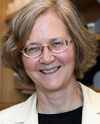UCSF's Blackburn Shares Columbia University's 2007 Horwitz Prize

Elizabeth Blackburn
Pursuit of Basic Questions about Cell Workings Leads to Insights into Aging and Cancer
Work by these researchers led to discovery of the structure of telomeres and telomerase. It was started to answer two very fundamental questions: what prevents the cell from destroying its own chromosomes, and what prevents the chromosomes from shrinking. Before the late 1970s and 1980s when the prize-winning work was performed, there were two mysteries about chromosomes. One, chromosomes are long lines of DNA so they have two ends, but cells recognize accidental breaks in chromosomes by their broken ends - why don't the cells try to repair the ends of chromosomes? And even if they did, this might have negative consequences, e.g. a cell could join two different chromosomes together. The second puzzle arose following discovery of how DNA copies itself. The process cannot copy the very ends of the chromosomes. So if the DNA is copied repeatedly (as in development, when DNA of one cell is copied in all subsequent cells) the chromosome eventually shortens so much that the cells are no longer viable. Researchers surmised that something unusual was occurring at the ends of the chromosomes, known as telomeres. Using animal models developed by Gall, Blackburn, then a research fellow in his lab at Yale, discovered a special DNA sequence - TTAGGG in humans - that is found nearly identically at the telomeres of nearly every type of animal and plant species. The telomeres protect the ends of the chromosomes and prevent them from opening up, which could result in separation of the two strands of DNA. Thus, the telomeres act as clamps on the ends of the chromosomes. In humans, there are thousands of these segments at the end of a chromosome. Later, in Dr. Blackburn's laboratory at Berkeley, she and Greider, then a research fellow, discovered an enzyme central to aging and cancer, which they named "telomerase." Though Gall, Blackburn and Greider did not set out to answer questions about aging, telomerase has provided answers. The sequencing of the telomeres and the discovery of telomerase has lead to an entirely new field of research that has yielded insights into the mechanisms of aging and the causes of cancer. Because most human cells have limited amounts of telomerase, they have a limited lifespan. Adding telomerase to human cells in culture dishes makes cells immortal, giving telomerase a dark side: almost all cancer cells produce telomerase to fuel their uncontrollable proliferation. Drugs that inhibit telomerase are currently being sought as potential new treatments for cancer.Related Links:
A Conversation with Elizabeth H. Blackburn: Finding Clues to Aging in the Fraying Tips of Chromosomes New York Times, July 3, 2007 Blackburn Awarded Honorary Doctorate by Princeton UCSF Today, June 6, 2007 The TIME 100: Elizabeth Blackburn TIME, May 3, 2007 UCSF Scientists Honored for Pioneering Studies of Aging, Cancer, Learning and Memory UCSF Today, January 3, 2007 Lasker Foundation: The Winners on Film
UCSF Today, September 26, 2006
Lasker Foundation: The Winners on Film
UCSF Today, September 26, 2006
 Chancellor Bishop Discusses the Significance of Elizabeth Blackburn's Lasker Award-Winning Research
UCSF Today, September 21, 2006
UCSF's Elizabeth Blackburn Receives Lasker Award
UCSF Public Affairs, September 18, 2006
Chancellor Bishop Discusses the Significance of Elizabeth Blackburn's Lasker Award-Winning Research
UCSF Today, September 21, 2006
UCSF's Elizabeth Blackburn Receives Lasker Award
UCSF Public Affairs, September 18, 2006
 Blackburn Explains Award-Winning Research
UCSF Today, March 16, 2005
Blackburn Lab
Blackburn Explains Award-Winning Research
UCSF Today, March 16, 2005
Blackburn Lab